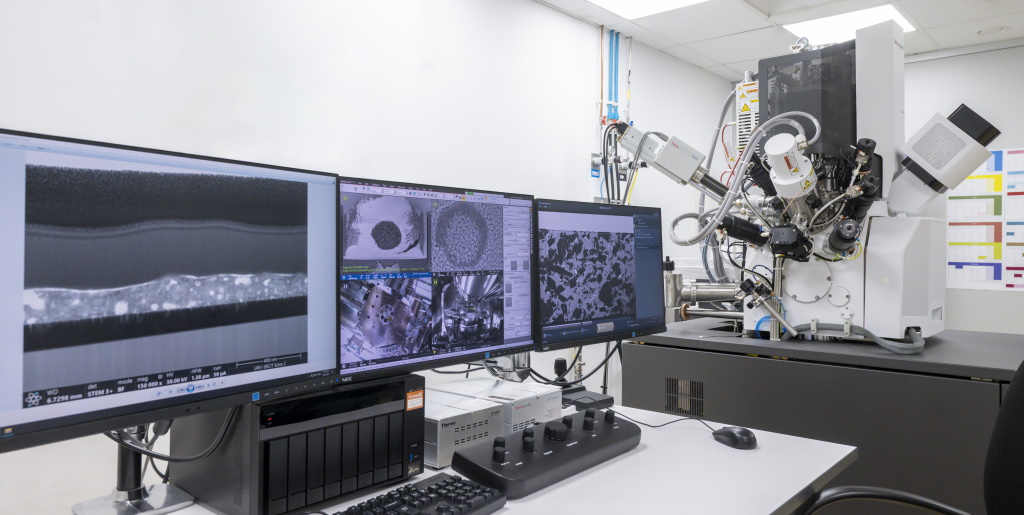- Advice
- Design and machining of prototypes or manufacture of micro and nano components
- Study of the morphology and physico-chemical distribution (including crystalline composition) in materials at the micro and nanometer scale
- Determination of the molecular structure of organic compounds
- Chemical analysis (qualitative and / or quantitative) of organic compounds (liquid / gas)
- Chemical analysis (qualitative and / or quantitative) of inorganic / organic compounds (solid)
- Determination of crystalline composition in materials
- Radiological Protection Technical Unit
- Other services

At the Scientific and Technical Resources Service we provide advice and specialized technological equipment to research staff. We offer comprehensive support at all stages of the research. From the approach, with the advice and selection of the most appropriate technology for each need; to the interpretation of the results obtained; through training for professionals who must use the equipment. Our goal is to help you meet your expectations efficiently.
Tell us your need and we'll see how we can help you!
Our main services are as follows.
-
Advice
We help you choose between different techniques to use to solve a problem (in the chemical field of structures, design, manufacturing, contamination, physical properties ... etc), we tell you the results that would be obtained and analyze the odds of being able to fix the problem.
-
Design and machining of prototypes or manufacture of micro and nano components
-
Manufacture of micro and nano components: Transfer of sub-micrometer scale designs and patterns on photosensitive resins. Deposition of uniform layers or nanoparticles of different elements and chemical compounds. Dry etching and microstructuring of substrates (Si, SiO2, etc.).
- Design and mechanization of prototypes: Elaboration of unique pieces (prototypes) to facilitate research processes (boxes for electronic devices or sensors, small reactors, etc.).
Available techniques
-
Study of the morphology and physico-chemical distribution (including crystalline composition) in materials at the micro and nanometer scale
The shape and size of particulate and non-particulate materials, on a micro and nanometer scale, as well as their elemental composition and distribution are determined. It is also determined how these elements are combined with each other to form both micro and nanometric crystalline matter. The techniques used are based on electronic image analysis, the interaction of matter with a high-energy beam (electrons, lasers or X-rays) and atomic repulsion forces.
Available techniques
- TEM
- FETEM
- ESEM-X-Ray microanalysis
- FESEM-FIB
- AFM
- Confocal microscopy
- Raman Spectroscopy
- Z-sizer
- X-Ray diffraction
- XPS
-
Determination of the molecular structure of organic compounds
The structure of pure compounds soluble in deuterated solvents can be determined qualitatively. Mixtures can also be quantified taking into account the sensitivity of the technique, in NMR, depending on the type of compound the limit of detection could be about 0.5%. The techniques used to evaluate the molecular structure are based on the (non-destructive) interactions of matter with radiation in the areas of radio frequency, infrared and UV-Vis (NMR, IRFT).
Available techniques
-
Chemical analysis (qualitative and / or quantitative) of organic compounds (liquid / gas)
Molecular mass information of an organic compound and its structural information are determined by mass spectrometry coupled to chromatography (liquid or gas). The techniques used in this characterization are based on the ionization of the sample to later separate the ions and molecular fragments according to their mass / charge ratio. Coupling with a separation technique such as liquid chromatography (HPLC) or gas chromatography (GC) allows the analysis, quantification and identification of a large number of compounds in complex mixtures. Mass spectrometry is therefore used at a qualitative and quantitative level, allowing very low detection limits to be reached.
Available techniques
-
Chemical analysis (qualitative and / or quantitative) of inorganic / organic compounds (solid)
The elemental, qualitative and quantitative composition of the solid matter (organic or inorganic) is determined by destructive and non-destructive techniques of the sample. The techniques used are based on the interaction of matter with a beam of electrons or X-rays (non-destructive) and with the spectral emission of ionized atoms in a plasma (destructive). The detection limit ranges from% to ppb. It is also determined how these elements are combined with each other and whether they are in crystalline form. Desorbed and ionized organic compounds on the surface of a solid can also be determined by laser (MALDI) and analyzed by high-resolution mass spectrometry (HRMS).
Available techniques
-
Determination of crystalline composition in materials
The crystalline phases that make up solid matter are determined qualitatively and quantitatively. The techniques used are based on the (non-destructive) interaction of matter with an electron beam or X-ray and the limit of detection is up to 0.1% by weight. They can also determine the amorphous fraction of a solid sample.
Available techniques
-
Radiological protection technical unit for second and third category radioactive installations and medical X-ray installation
The Radiological Protection Service (SPR) is a Radiological Protection Technical Unit (UTPR) authorized by the Nuclear Safety Council since 1997. It focuses its activity in the field of protection of professionals, patients and the general public. health centers in the face of the possible effects of ionizing radiation.
-
Other services
In addition to all the services and techniques listed above...
We also offer you
We offer comprehensive support at all stages of the research.
